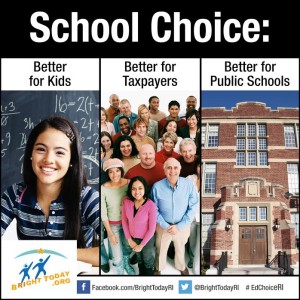The Math of Educational Choice
Introducing the RI-DIMES Fiscal Modeling Tool
Empowering parents with greater choices when it comes to determining the best educational path for their children is not only supported by strong moral arguments, but can also lead to a net positive fiscal impact on the bottom line of public school districts, very different from the math of charter schools.
Read “The Math of Educational Choice” report
Click here for a school-district by school-district summary table of fiscal results
EXECUTIVE SUMMARY

The Center, in conjunction with a PhD economics professor, has developed a fiscal modeling tool, Rhode Island District Impact Model for Educational Scholarships (RI-DIMES), that can project the statewide and district-by-district fiscal impact of the educational scholarship program component of the 2015 bipartisan legislation submitted in both the Rhode Island House of Representatives and Senate. In March 2015, the Center published a report, The Way of the Future, describing the Bright Today Scholarship program outlined by the legislation.
The RI-DIMES projections demonstrate that conventional beliefs about the fiscal effects of voucher-type scholarship programs exaggerate
the risk and, if the policy is well designed, do not apply at all.
In the first year, with fewer than 3% of public school students expected to opt for scholarships, which are capped at $6,000, RI-DIMES projects, under the “core” policy providing scholarships to current public school students who migrate out of the system (including new students), that:
- Public school districts will see large aggregate net fiscal savings. With statewide savings expected to reach $17 million, 33 of 36 local districts will realize net savings in the first year. This figure could rise to $32 million per year and include all districts but one, under more-optimistic assumptions.
- Funding per public school student will actually rise in every school district, by an average statewide increase of $316.
- Total public and private spending on education will increase by $17.2 million, because the scholarships will provide an incentive for families to invest more of their private dollars into their children’s education.
When considering a “universal” policy as described in current legislation, in which current private school students are also granted partial scholarships, the net fiscal impact for public school districts is diminished, providing a wider range of possible first-year outcomes:
- Under the projected assumptions, statewide savings would drop to about $1.85 million, with 50% of the public school districts still realizing net savings.
- Under more-optimistic assumptions, all but
one school district would realize net savings, with the statewide total savings approaching
$18 million per year.
With our public school buildings in dire need of repair and maintenance, and with property taxes already high across the state, the proposed educational savings account legislation in just five years could free up $85 million to $150 million in revenue that could be applied to relieve these two pressing issues.


Leave a Reply
Want to join the discussion?Feel free to contribute!